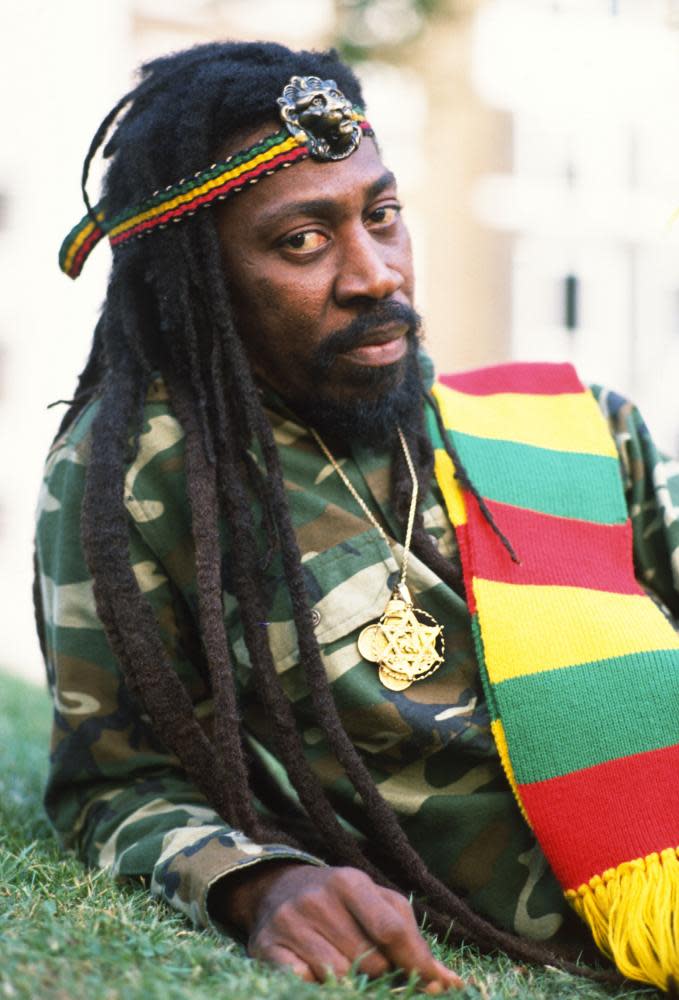The brilliant Bunny Wailer pushed reggae forward on his own terms
The documentary film Fire in Babylon, the story of the West Indies cricket team of the 70s and 80s, is peppered with contributions from that all-conquering side, but the show was comprehensively stolen less than five minutes in by the nattily dressed Bunny Wailer sitting on a boulder. He is eloquent and insightful, talking about the significance of that team to black people in the Caribbean but increasingly loses his cool with a dog barking off camera. In a flash, the articulate academic tones disappear, he whips off his dark glasses and shouts “Clap him again!” Then, almost smirkingly, uses this as an analogy for how Jamaicans approach cricket.
The dog has a cameo later in the film, only for Wailer to almost affectionately shoo it away, and it’s all as vivid an illustration as anything musical of who he was: smart, drily funny, not to be trifled with but not really as fierce as he came across. Indeed, it was as much a balance of personalities among Bunny, Peter Tosh and Bob Marley that made their group the Wailers so appealing: Tosh, a six-foot-seven streak of barely controlled anger; Marley a quasi-hippie who understood the rock world, and the pragmatic Bunny, who valued his artistic and sociopolitical freedom.
When he left the Wailers in between Burnin’ and Natty Dread it didn’t appear an easy decision – he and Marley were friends from childhood and had a half-sister in common, Claudette, born to Wailer’s dad and Marley’s mum. But for anybody who knew Wailer, it wasn’t a surprise: he didn’t so much want success in its own right, he wanted it on his own terms. The marker for what was possible under those terms was Blackheart Man, his solo debut in 1976, and one of the half a dozen truly great roots reggae albums.

The set was pure Bunny Wailer, thoughtful subject matter made all the more hard-hitting by the sweet singing, showcasing so much of what hadn’t been apparent in the Wailers’ most recent manifestation: his songwriting skills, his agile and seductive tenor, his nuanced dark’n’light approach to his roots subject matter and a sense of irony – the blackheart man was the mythical Rastaman/bogeyman figure Jamaican parents would reference to scare their children. That’s why it works: it’s honest and unashamed.
The LP was instantly and internationally successful, even in the US where reggae traditionally struggled, but Wailer hated touring, he liked flying even less and rarely did press or promotion. He would only came down to Kingston from his farm if he absolutely had to. And while this first album came on Island Records, he set up his own label, Solomonic, for subsequent releases.
What Wailer shrewdly achieved was creative independence, coupled with an international presence. The wider music world continued to want to know what he was doing; his holing up in Jamaica allowed him to do it without interference. By opting not to work within the conventional system, or in some cases even acknowledge it, Wailer bought himself the freedom to experiment and interact with his Jamaican audience first. Vitally, this meant he could explore and contribute to reggae as it developed at grassroots level, rather than remain on the corporately defined carousel, and he has been celebrated as one of the few leading reggae artists to transcend genres within the music.
Of course, it didn’t always come off – his disco dabblings are best not mentioned out loud – but Wailer’s excursions into dancehall and digital reggae, with his roots and culture credentials intact, surprised a lot of people outside Jamaica. The album Bunny Wailer Sings the Wailers updates some of the trio’s early hits while remaining true to the originals, deftly demonstrating how so much modern Jamaican music was interlocking.
Of course another aspect of Wailer’s shift away from the mainstream music business was his total immersion in Rastafari. A personal and deeply spiritual part of his life, his all-round independence allowed him to express his faith as he saw fit. The somewhat regal, brilliant white robes or the officer uniform-style suits became something of a trademark; the first time I met him he was smoking weed in a sizeable but beautiful curved Meerschaum-type pipe with a Rastaman carved as the bowl.
Of course, the strength of these convictions could sometimes be a pain in the rear. He once kept me and a BBC film crew standing about for several hours on the street in Kingston, waiting for him to arrive at a venue he was already inside. Years later, when I was working on a project with his manager, I mentioned this and she roared with laughter, but her reply made perfect sense: “I hope you didn’t take that personally. It wasn’t you he was keeping waiting, it was Babylon: the BBC.”
This, like the dog, was all part of Wailer flexing who he was, but ultimately not wanting to do any harm. And he deserved that right, because since his Studio One days of the early 60s, he had been working to move Jamaican music forward – and even more so after turning his back on the group to put Jamaica and grassroots reggae first.

 Yahoo Movies
Yahoo Movies 
